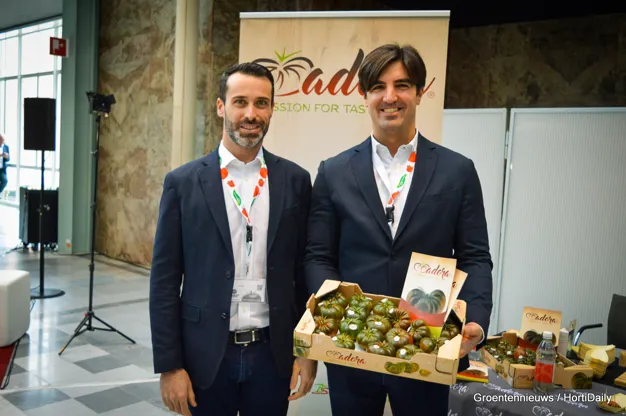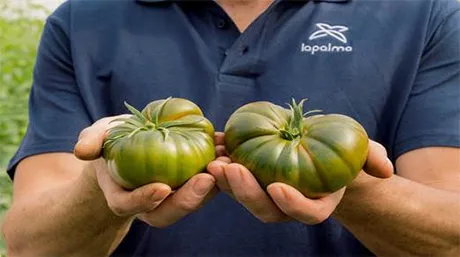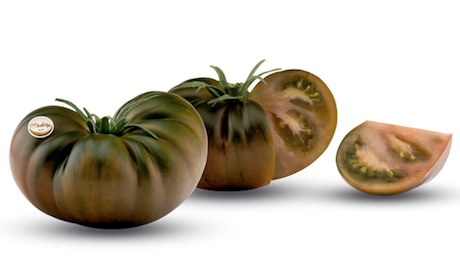Raf tomatoes are amongst the most recognizable ones in the industry and are known to be authentic for Spain. Bred into existence there more than 50 years ago, the tomato can be recognized by its color and intense sweet flavor, but is also marked by its relatively short shelf life. Since two years there have been new Raf products on the market that buck this trend. La Palma’s Adora tomato for example has the characteristic sweet Raf flavor, but has a long enough shelf life to be shipped to other EU countries. Juan Gallego from La Palma explains how this is a type of Raf tomato that can be mass produced and has a good shelf life. However it’s not easy to keep the taste in its place. “Optimum flavor is reached by asking most of the plant. We’re continuously looking for the right balance in growing.”

Victor Folk & Juan Gallego of La Palma (Global Tomato Congress 2019)
Launch of the Adora brand
Normally they’re competitors but for the Adora tomato we simplify in 2 growers (La Palma & Verdita). Last year and in collaboration with breeder HM. Clause the Spanish companies Verdita & La Palma launched Adora to set up a better market for Adora tomato. And ever since, the tomato has found its way in and outside Spain. It can be found in the UK, in Belgium and Netherlands, in Germany. “Growers have tried to grow it local, but even though you can use the same variety, it turned out to be impossible to get the same organoleptic qualities”, Juan from La Palma says. “It’s the Spanish conditions and our growth strategy that gives it the specific taste.”
The seed for this particular variety was launched by HM Clause two years ago and according to Juan it’s one of the few varieties offering this much taste in a tomato of this size. “The yield of this variety is not high, so the production is very different from regular tomatoes. With this variety you get less kilos per square meter – lower yield like this often result in better flavor.”

Getting most out of the tomato
In addition La Palma uses an interesting technique to get the most out of the tomato. In order to maximize the flavor of the tomato they push the crop to its limits. ““We use as little water as possible. We possibly could increase the yield by giving more water, but when it becomes too big the flavor will decrease. The more compact the tomato is, the more flavorful, and flavor is the most important aspect of the Adora tomato”, Juan explains. “So we give it just enough water to stay alive. We keep the crop on the edge of surviving during the growing process in order to get a nice flavor profile.”
It is quite difficult to grow this way. “One mistake and you could lose your yield, but the flavor is worth it.” He explains how the flavor is something different, especially for this size tomato. “All tomatoes marketed under the Adora name have a Brix value of 7+ - it’s a must to be branded.” The Primora and the Sweet Normande are additions to the La Palma assortment: offering the tomato with resp. a Brix between 6-7 or 5-6.

Coloring
The tomato is black when it’s ripe, this also when it is the sweetest. “It’s remarkable to see that in Southern Europe the sweet taste is favorite, whereas in more Northern regions a slightly more acid balance is favored. At the beginning this tomato’s flavor profile is mainly acidic, but as it matures it becomes sweeter – it loses acidity every single day. It still has a great flavor when it’s green and more acidic. The tricky part with this tomato is to get the balance between sugar and acidity. So if the customer prefers a bit more acidity they can eat the tomato earlier, and if they prefer it sweeter they can give it some time to ripen. To me the optimal time to eat the tomato would be 3-5 days after harvesting, but the Adora has the perfect taste to offer to everyone.”
For more information:
La Palma
Daniel Rodríguez
jdrodriguez@granadalapalma.com
www.granadalapalma.com
Verdita
Miguel Ángel
mangel@verdita.es
www.verdita.es
HM. Clause
Manuel Ferrer
manuel.ferrer@hmclause.com
www.hmclause.com
